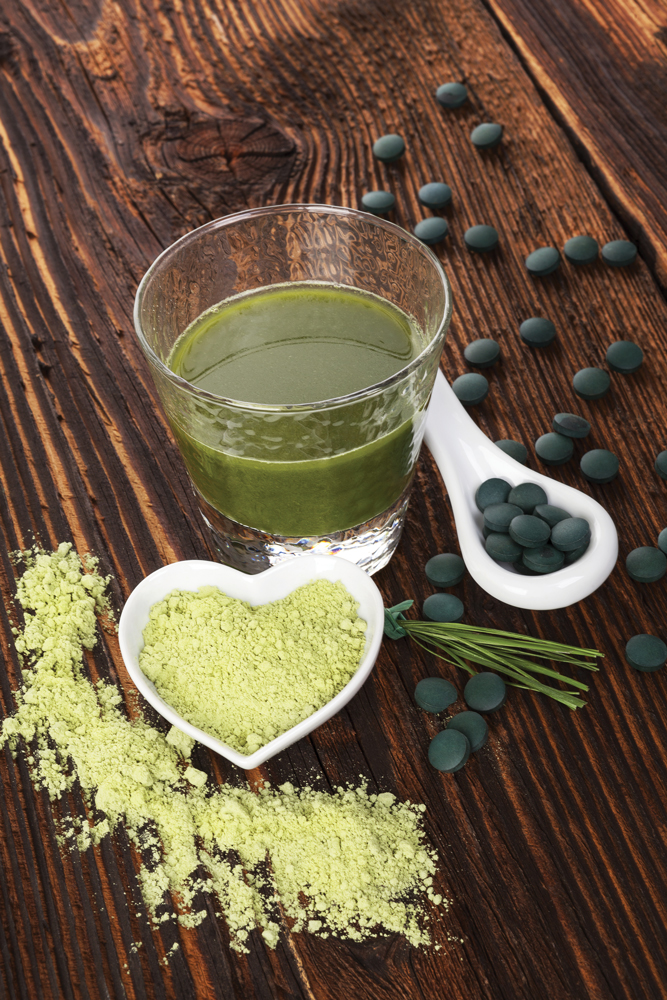Green and whole foods’ new look crosses the bridge between food and supplement.
How many of your customers actually eat multiple servings of fresh fruits and vegetables every single day without fail? Whatever that number is, it really isn’t enough.
In 2009, the Centers for Disease Control (CDC) surveys indicated that only 33 percent of adults meet the recommendation for fruit consumption and 27 percent get the recommended servings of vegetables. “A diet high in fruits and vegetables is important for optimal child growth, maintaining a healthy weight, and prevention of chronic diseases, such as diabetes, heart disease and some cancers, all of which currently contribute to health care costs in the United States,” said Dr. William H. Dietz, director of CDC’s Division of Nutrition, Physical Activity, and Obesity.
Truth is, increasingly “full-plate” hectic lifestyles leave little time or opportunity for many people to obtain the wide spectrum of optimal nutrition needed from a daily diet. This is the sweet spot for today’s cache of green/whole foods.
This supplement category has seen some dramatic alterations in the past several years, as brand marketers formulate to fulfill health-minded consumers’ needs for nutritionally dense “supple-foods” that don’t cramp lifestyles.
“In recent years, we’ve seen a huge increase in consumer demand for whole-food supplements that not only offer the alkalizing power of greens, but that also deliver specific functional benefits,” observed Ryan Therriault, vice president of marketing and innovation, Amazing Grass, Newport Beach, CA. Therefore, he said, Amazing Grass has created green-specific products for energy (Green SuperFood Watermelon Energy), sports nutrition/protein (Amazing Meal), and immune support (Green Superfood Tangerine Immunity Defense), among others.
He added that consumers expect this category to be innovated beyond the simple convenience green powders to fulfill evolving consumer needs. “As more consumers become aware of the benefits of eating whole foods and nutrient-rich greens, we find many are increasingly looking in the supplement section for easy ways to achieve optimal health through the power of greens when they don’t have time to cook. In addition to developing new lines that deliver specific functions combined with the nutrition of whole greens, we’ve also improved upon taste in all our products with finer powders and attractive flavor combinations to appeal to newcomers to the greens category while giving avid users new options.”
In the green-/whole-foods category, Stacey Gillespie, director of product marketing with New Hampshire-based MegaFood, said she has noticed a shift in preference from tablets to powdered supplements. Powders are convenient, easier to ingest, and closest to the whole food as possible. As Baby Boomers age, she noted, swallowing tablets can become more difficult, so we are seeing a shift to using powders to obtain their nutrients. “On the other hand, Millennials are all about convenience; they want to obtain as much nutrition as possible, and are also looking to add to the foods they are already consuming.” Millennials prefer powders because of the versatility that allows for tasty and nutritious additions to smoothies and juices, which are popular for this generation.
Millennials and others are now able to enjoy using green/whole foods powders in a variety of ways due to the improved technology in palatability, Gillespie added. “We are seeing more natural sweeteners and flavorings being added to supplements that were not available five to 10 years ago,” she commented.
In the viewpoint of Andrew Aussie, chief operating officer and executive vice president of California-based Coromega Company, consumers are increasingly seeking whole-food solutions over traditional supplements, moving away from pills to liquids and other alternate forms, such as emulsified supplements. Coromega’s Be Bright superfood oil blend, for example, combines a true whole food form—whole food oils—in a non-traditional liquid “squeeze” format. “Additionally,” he agreed with Gillespie, “as more and more consumers are making juices and smoothies at home, whole food supplements that are easy to add, like liquids and powders, are gaining favor with consumers as ‘enhancers’ to what they’re already making.”
Ron Siebold, co-founder of Kansas-based Pines International, said he believes that the most significant change in the green/whole foods categories has been the recognition of the importance of prebiotic foods in providing the best environment for probiotic bacteria. He explained: “Up until recently, consumers were often locked into believing that juices were the best way to consume vegetables. Now, with recent evidence linking the importance of fiber in vegetables to slow the transit time in the digestive tract and to provide ‘intestinal fill’ for the colon to effectively promote the growth of probiotic bacteria, juice machines have been replaced by Magic Bullets, Vita Mixers, and other blenders that produce whole food smoothies. In a like manner, juice powders from vegetables like cereal grass and alfalfa are no longer as popular as the whole leaf form, which not only provide better nutritional support but also cost less.”
Defining the Category
For millions of consumers vowing to eat healthier diets, the idea of “green” foods is one that evokes bad-tasting thick green juice. They conjure either grass or algae, and as retailers you likely have heard this “objection” uttered by many new to the healthy and natural lifestyle.
At one time, this was true. A long time ago. Now, however, it is an exciting category that can appeal to many tastes and health goals.
Alene Johnson, director of product education with Washington-based Barlean’s, explained that the company includes plant-based nutrients that fall under the category of traditional “green” ingredients like grasses, as well as the brightly colored, antioxidant-rich nutrients from various fruits, veggies, berries and cocoa. The company offers two “green” formulas and two formulas that are plant-based antioxidants.
MegaFood, said Gillespie, defines whole-/green-foods supplements as any supplement, which delivers nutrients and micronutrients in a complex food form. “A whole-foods supplement delivers foods to consumers closest to how they would find them in nature. MegaFood employs its Slo-Food Process, which delivers a vitamin or mineral in a complex food form so that it has all of the other vital factors with no essential nutrients being compromised.
Coromega defines food supplements as products “hewing directly from their whole food natural form,” described Aussie. “We think it’s moved way beyond the typical wheat grass and algae, and by using whole food sources in non-traditional formats like emulsified liquids, we also think the line is blurring between what’s a ‘food’ and what’s a ‘supplement.’”
Seibold explained that although Pines provides juice powders, which are the dried juice from cereal grass and alfalfa, its main products are directly harvested leaves of cereal grasses and alfalfa that have been dried in the whole-leaf form at the lowest temperatures of any whole-leaf producer. “Instead of being juiced to make the nutrients easily absorbed, the dried whole leaf is milled to a powder with a particle size much finer than could ever be chewed and, of course, with the fiber still present for the prebiotic benefits,” he said.
Amazing Grass defines the category as those supplements made with real, whole food ingredients—such as wheat, barley and alfalfa grass—that help support vitality and maintain a healthy lifestyle. Now, those green-/whole-foods supplements, Therriault asserted, also have to be “non-GMO (genetically modified organism), made with certified organic greens, and specially formulated to help detoxify and cleanse the body while naturally boosting energy levels and supporting the immune system.”
As with any evolved category, trends pop up that are intriguing. Powders, reiterated Gillespie, continue to be on the rise, with double-digit growth in the past few years. Much of the growth, she noted is for consuming in a more well-rounded food/meal matrix such as a smoothie. MegaFood Nutrient Booster Powders, such as Daily C-Protect, are selling very well, she reported.
Seibold went a step further to say that juice powders are being eclipsed by whole food powders.
Coromega pointed to the continued growth of healthy fats/EFAs, yet many folks balk at “fish burp” omega-3 pills. Demand has also grown beyond marine-sourced EFAs, said Aussie, and now include superfood oils such as coconut, chia, hemp, black cumin and avocado—a more whole profile. “We have emulsified these oils, making them easier to absorb and more delicious to take,” he said. “Consumers can gain the full spectrum of health benefits these oils provide, easily.”
Johnson sees strong growth in green devotees. “We know that there are many ‘truly green’ green food followers!” To satisfy veteran and new green foods followers, the company formulated Barlean’s Organic Greens and Barlean’s Organic Berry Greens, abundant in grasses, spinach, and parsley. Barlean’s Superfruit Greens and Barlean’s Chocolate Silk Greens contain green foods and are also “way over the top in brightly colored fruits, veggies, berries and even natural cocoa. The colors of both of these products tell consumers that they are both very high in antioxidant value,” she described.
Johnson also mentioned that scores of parents trying to find a way for their family to embrace a healthier diet. They need replacements for unhealthy food choices. “We certainly take that route with our product demos and even mention it on our packaging,” she commented. Barlean’s Chocolate Silk Greens mixed with almond milk, for example, is a tasty and nutritious alternative for traditional, sugar-laden chocolate milk.
Detoxing
According to Therriault, research has shown that toxic build up from the Western diet and exposure to environmental pollutants, preservatives and heavy metals can affect metabolism and organ function, which can lead to poor health. Consumers are increasingly aware of living in toxic environments, and are seeking ways to counterbalance it through some sort of detox programs and gentle detoxing and pH balancing supplements. “Our new Alkalize & Detox Green SuperFood, which since launched in 2015 has quickly become one of our most popular items. Specifically designed to help the body achieve ideal pH levels while simultaneously ridding it of toxins to allow for optimal function and organ restoration, Alkalize & Detox offers a convenient way for people to cleanse from the inside without feeling deprived or spending hours prepping in the kitchen,” he said.
“Without prepping in the kitchen” may sound like a bit of a death knell to your organic produce department, but it certainly doesn’t have to be. Health-minded consumers do make meals from scratch, just not as often as they want to or are able to. Remember, even the 1950s housewives “cheated” by serving up TV dinners for their families. Throughout the decades, even moms who like to cook need respite from the kitchen.
Retailing Greens
There are ways to grow the green/whole foods categories for today’s nutrition-minded moms, and busy singles. Find your most artistic staffer to create colorful, eye-catching signs for your produce department; signage should simply convey, “Don’t have time to prep and cook? Visit aisle XX for our green/whole foods supplements.”
Gillespie advised focusing on in-store and live demonstrations of the product. “Live demos and sampling smoothie recipes with the staff’s favorite products is a great way to provide both education and purchase motivation to consumers,” she suggested. “Taste is a driving factor in trying new products, and consumers can be very apprehensive to purchase products if they don’t know how it tastes. Live trial is an immediate way for consumers to think, ‘I can actually drink this, adding nutrients to my diet is easy.’”
Aussie observed the smartest efforts at retail distinguish the section with signage, collateral and displays. Coromega, he said, provides shelf collateral and educational materials for the store staff, plus samples for staff and consumers. When staff can sample the products, they are much more authoritative and convincing advocates for consumers to purchase. “Compelling collateral and samples can really help consumers understand more and ‘test drive’ products before they purchase. Additionally, we provide strong discounts at the outset and shelf displays that we find also help both the store and consumer incentivize quick trial,” he added.
Therriault suggested that retailers take advantage of key times of year when consumers are thinking more about their health/diet and are more likely to try a green supplement for the first time (or stock up). For example, he offered, alkalizing products during the New Year and summertime when consumers are trying to detoxify and get back to clean eating habits, or bringing in holiday flavors during the season when consumers want to immerse themselves in the holiday spirit but in a healthy way. “We’ve also seen great success in placing dedicated shippers with key flavor call outs and offering single trial packs so shoppers can try a few flavors before committing to a whole canister.”
Barlean’s has created a booklet filled with company staffers’ favorite Greens recipes, says Johnson. “You would be amazed at how creative the recipes are—how about strawberry-kiwi banana popsicles?” she enthuses. Barlean’s Greens recipe booklets contain 21 healthy, gluten-free recipes and are free to retailers who can share them with their customers at no charge.
There is a compelling educational component, according to Seibold, which should be made prominent. “The important point that retailers need to emphasize to customers is that the USDA (U.S. Department of Agriculture) and just about every nutritionist and medical doctor now recognizes that most people do not eat enough dark green leafy vegetables,” Seibold asserted. Green superfoods, if grown and harvested properly, are a suitable way to increase these foods—and the nutrients they contain—in one’s diet.”
He added not to forget that many people still do like to consume green foods in pill form, in addition to obtaining whole nutrients in supplemental powders, etc. “For those who don’t want to take the time to mix powders with liquids, tablets of Pines Wheat Grass, Pines Barley Grass and Pines Alfalfa, or Pines Green Duo capsules are convenient ways to increase the dark-green, leafy vegetables in one’s diet.”
The green/whole foods category continues to grow with tasty, convenient offerings. Rather than a fringe product group, green/whole foods is becoming the go-to foundation supplement in consumers’ daily routines for achieving and sustaining vibrant health and well-being. And today’s green/whole food, or “supple-food,” truly epitomizes the marriage of nutrient-dense foods and dietary supplements. VR
For More Information:
Amazing Grass, (866) 472-7711
Barlean’s, (800) 445-3529
Coromega, (877) 275-3725
Megafood, (800) 848-2542
Pines International, (800) 697-4637





![[Sponsored Video] Special Report: Bergamonte®, the Untold Story](https://vitaminretailer.com/wp-content/uploads/2023/06/sponsored-video-special-report-b-300x169-1707947265.jpg)







